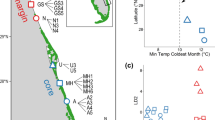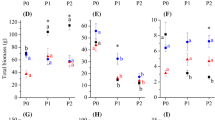Abstract
Factors modulating introgressive hybridization between the red mangrove species Rhizophora mangle and R. racemosa in spatially defined sites are poorly understood. To investigate this, we evaluated the reproductive phenology and the nutrient and physiological traits in those two species and their F1 hybrids genotyped with microsatellite data across a natural hybrid zone from the Pacific coast of Panama. We found no evidence that reproductive phenology represents a barrier to gene flow, because R. mangle and the F1 hybrids produced flowers and propagules throughout the annual cycle, while R. racemosa flowered only in the dry season. Soil nutrient concentrations decreased landward, while soil salinity varied only slightly. Foliar nutrients and δ15N signatures varied according to the soil nutrient gradient, but only foliar phosphorus and carbon varied among species. In contrast, two structural variables (height and trunk diameter) and leaf variables related to salinity tolerance (Na, Cl:Na, K:Na, cation:anion) and water-use efficiency (i.e., δ13C) differed among species, suggesting higher salinity tolerance for R. mangle and F1 hybrids compared with R. racemosa. We conclude that parental species and F1 hybrids differ in salinity tolerance and water-use efficiency, which could be associated with adaptive evolution of the red mangrove hybrid complex.






Similar content being viewed by others
References
Afzal-Rafii Z, Dodd RS, Fauvel MT (1999) A case of natural selection in Atlantic-East-Pacific Rhizophora. Hydrobiologia 413:1–9
Agraz-Hernández CM, García-Zaragoza C, Iriarte-Vivar S, Flores-Verdugo FJ, Casasola PM (2011) Forest structure, productivity and species phenology of mangroves in the La Mancha lagoon in the Atlantic coast of Mexico. Wetlands Ecol Manage 19:273–293. doi:10.1007/s11273-011-9216-4
Anderson E, Thompson E (2002) A model-based method for identifying species hybrids using multilocus genetic data. Genetics 160:1217–1229
Arnold ML (2006) Evolution through gene exchange. Oxford University Press Inc, New York
Arnold ML, Ballerini ES, Brothers AN (2012) Hybrid fitness, adaptation and evolutionary diversification: lessons learned from Louisiana Irises. Heredity 108:159–166
Baack EJ, Rieseberg LH (2007) A genomic view of introgression and hybrid speciation. Curr Opin Genet Dev 17:513–518
Ball MC (1988) Ecophysiology of mangroves. Trees Struct Funct 2:129–142
Ball MC (1996) Comparative ecophysiology of tropical lowland moist rainforest and mangrove forest. In: Mulkey SS, Chazdon RL, Smith AB (eds) Tropical forest plant physiology. Chapman & Hall, New York, pp 461–496
Ball MC, Farquhar GD (1984) Photosynthetic and stomatal responses of the grey mangrove, Avicennia marina, to transient salinity conditions. Plant Physiol 74:7–11
Breteler FJ (1969) The Atlantic species of Rhizophora. Acta Bot Neerl 18:434–444
Breteler FJ (1977) America’s Pacific species of Rhizophora. Acta Bot Neerl 26:225–230
Cernusak LA, Ubierna N, Winter K, Holtum JA, Marshall JD, Farquhar GD (2013) Environmental and physiological determinants of carbon isotope discrimination in terrestrial plants. New Phytol 200:950–965
Cerón-Souza I, Rivera-Ocasio E, Medina E, Jimenez JA, McMillan WO, Bermingham E (2010) Hybridization and introgression in New World red mangroves, Rhizophora (Rhizophoraceae). Am J Bot 97:945–957
Clough B (1984) Growth and salt balance of the mangroves Avicennia marina (Forsk.) Vierh. and Rhizophora stylosa Griff. in relation to salinity. Funct Plant Biol 11:419–430
Cornejo X (2013) Lectotypification and a new status for Rhizophora x harrisonii (Rhizophoraceae), a natural hybrid between R. mangle and R. racemosa. Harv Pap Bot 18:37
Crawley MJ (2007) The R book. Wiley-Blackwell, Chichester
de Menezes MPM, de Oliveira D, de Mello CF (1997) Pollination of red mangrove, Rhizophora mangle, in Northern Brazil. Acta Horticulturae (ISHS) 437:431–434. http://www.actahort.org/books/437/437_457.htm
Duke NC, Allen JA (2006) Rhizophora mangle, R. samoensis, R. racemosa, R. × harrisonii (Atlantic–East Pacific red mangroves), ver. 2.1. In: Elevitch CR (ed) Species profiles for Pacific Island agroforestry. Permanent Agriculture Resources (PAR), Holualoa, Hawaii, USA
Duke NC, Lo EYY, Sun M (2002) Global distribution and genetic discontinuities of mangrove emerging patterns in the evolution of Rhizophora. Trees 16:65–79
Ellison AM, Farnsworth EJ, Twilley RR (1996) Facultative mutualism between red mangroves and root-fouling sponges in belizean mangal. Ecology 77:2431–2444
Evanno G, Regnaut S, Goudet J (2005) Detecting the number of clusters of individuals using the software structure: a simulation study. Mol Ecol 14:2611–2620
Falush D, Stephens M, Pritchard JK (2003) Inference of population structure using multilocus genotype data: linked loci and correlated allele frequencies. Genetics 164:1567–1587
Falush D, Stephens M, Pritchard JK (2007) Inference of population structure using multilocus genotype data: dominant markers and null alleles. Mol Ecol Notes 7:574–578. doi:10.1111/j.1471-8286.2007.01758.x
Fernandes MEB (1999) Phenological patterns of Rhizophora L., Avicennia L. and Laguncularia Gaertn. f. in Amazonian mangrove swamps. Hydrobiologia 413:53–62
Flowers TJ, Colmer TD (2008) Salinity tolerance in halophytes. New Phytol 179:945–963
Fry B (2000) δ15N studies of nitrogen use by the red mangrove, Rhizophora mangle L. in South Florida. Estuar Coast Shelf Sci 50:291–296. doi:10.1006/ecss.1999.0558
Gill AM, Tomlinson PB (1971) Studies on the growth of red mangrove (Rhizophora mangle L.) 3. Phenology of the shoot. Biotropica 3:109–124
Huber SC (1985) Role of potassium in photosynthesis and respiration. In: Munson RD (ed) Potassium in agriculture. American Society of Agronomy, Madison, pp 369–396. doi:10.2134/1985.potassium.c15
Jiménez JA (1987) A clarification on the existence of Rhizophora species along the Pacific coast of Central America. Brenesia 28:25–32
Jiménez JA (1988) Floral and fruiting phenology of trees in a mangrove forest on the dry Pacific coast of Costa Rica. Brenesia 29:33–50
Kao WY, Chang KW (1998) Stable carbon isotope ratio and nutrient contents of the Kandelia candel mangrove populations of different growth forms. Bot Bull Acad Sin 39:39–45
Li N, Chen S, Zhou X, Li C, Shao J, Wang R, Fritz E, Huttermann A, Polle A (2008) Effect of NaCl on photosynthesis, salt accumulation and ion compartmentation in two mangrove species, Kandelia candel and Bruguiera gymnorhiza. Aquat Bot 88:303–310. doi:10.1016/j.aquabot.2007.12.003
Lin GH, Sternberg LDL (1992a) Differences in morphology, carbon isotope ratios, and photosynthesis between scrub and fringe mangroves in Florida, USA. Aquat Bot 42:303–313
Lin GH, Sternberg LDL (1992b) Effect of growth form, salinity, nutrient and sulfide on photosynthesis, carbon isotope discrimination and growth of red mangrove (Rhizophora mangle L). Aust J Plant Physiol 19:509–517
Logan M (2010) Biostatistical design and analysis using R: a practical guide. Wiley-Blackwell, Chichester
Lopez-Hoffman L, DeNoyer JL, Monroe IE, Shaftel R, Anten NPR, Martinez-Ramos M, Ackerly DD (2006) Mangrove seedling net photosynthesis, growth, and survivorship are interactively affected by salinity and light. Biotropica 38(5):606–616
Lovelock CE, Feller IC (2003) Photosynthetic performance and resource utilization of two mangrove species coexisting in a hypersaline scrub forest. Oecologia 134(4):455–462
Lowry DB, Modliszewski JL, Wright KM, Wu CA, Willis JH (2008) The strength and genetic basis of reproductive isolating barriers in flowering plants. Philos Trans R Soc B 363:3009–3021
Mallet J (2005) Hybridization as an invasion of the genome. Trends Ecol Evol 20:229–237
Martin NH, Bouck AC, Arnold ML (2005) Loci affecting long-term hybrid survivorship in Louisiana Irises: implications for reproductive isolation and introgression. Evolution 59:2116–2124. doi:10.2307/3449097
Martin NH, Bouck AC, Arnold ML (2006) Detecting adaptive trait introgression between Iris fulva and I. brevicaulis in highly selective field conditions. Genetics 172:2481–2489. doi:10.1534/genetics.105.053538
McKee KL, Feller IC, Popp M, Wanek W (2002) Mangrove isotopic (δ15N and δ13C) fractionation across a nitrogen vs. phosphorus limitation gradient. Ecology 83:1065–1075
Medina E, Francisco M (1997) Osmolality and δ13C of leaf tissues of mangrove species from environments of contrasting rainfall and salinity. Estuar Coast Shelf Sci 45:337–344
Medina E, Cuevas E, Popp M, Lugo AE (1990) Soil salinity, sun exposure, and growth of Acrostichum aureum, the mangrove fern. Bot Gaz 151:41–49
Medina E, Giarrizzo T, Menezes M, Carvalho Lira M, Carvalho EA, Peres A, Silva B, Vilhena R, Reise A, Braga FC (2001) Mangal communities of the “Salgado Paraense”: ecological heterogeneity along the Bragança peninsula assessed through soil and leaf analyses. Amazoniana 16:397–416
Medina E, Francisco M, Quilice A (2008) Isotopic signatures and nutrient relations of plants inhabiting brackish wetlands in the northeastern coastal plain of Venezuela. Wetlands Ecol Manage 16:51–64
Mehlig U (2006) Phenology of the red mangrove, Rhizophora mangle L., in the Caete Estuary, Para, equatorial Brazil. Aquat Bot 84:158–164
Muller J, Caratini C (1977) Pollen of Rhizophora (Rhizophoraceae) as a guide fossil. Pollen Spores 19:361–390
Pritchard JK, Stephens M, Donnelly P (2000) Inference of population structure using multilocus genotype data. Genetics 155:945–959
R Core Team (2013) R: A language and environment for statistical computing. R Foundation for Statistical Computing
Rieseberg LH, Soltis DE (1991) Phylogenetic consequences of cytoplasmic gene flow in plants. Evolutionary Trends in Plants 5:65–84
Rieseberg LH, Wendel JF (1993) Introgression and its consequences in plants. In: Harrison RG (ed) Hybrid zones and the evolutionary process. Oxford University Press, Oxford, pp 70–109
Sánchez-Núñez DA, Mancera-Pineda JE (2011) Flowering patterns in three neotropical mangrove species: evidence from a Caribbean island. Aquat Bot 94:177–182. doi:10.1016/j.aquabot.2011.02.005
Sánchez-Núñez DA, Mancera-Pineda JE (2012) Pollination and fruit set in the main neotropical mangrove species from the Southwestern Caribbean. Aquat Bot 103:60–65. http://dx.doi.org/10.1016/j.aquabot.2012.06.004
Santos-Fernandez E (2011) Johnson: Johnson Transformation. R package version 1.1. http://CRAN.R-project.org/package=Johnson
Savory HJ (1953) A note of the ecology of Rhizophora in Nigeria. Kew Bull 1:127–128
Scascitelli M, Whitney KD, Randell RA, King M, Buerkle CA, Rieseberg LH (2010) Genome scan of hybridizing sunflowers from Texas (Helianthus annuus and H. debilis) reveals asymmetric patterns of introgression and small islands of genomic differentiation. Mol Ecol 19:521–541
Smith TJ III (1992) Forest structure. In: Robertson AI, Alongi DM (eds) Tropical mangrove ecosystems. American Geophysical Union, Washington DC, pp 101–136
Steffens DL, Sutter SL, Roemer SC (1993) An alternate universal forward primer for improved automated sequencing of M13. Biotechniques 15:580–582
Takayama K, Tamura M, Tateishi Y, Kajita T (2008) Isolation and characterization of microsatellite loci in the red mangrove Rhizophora mangle (Rhizophoraceae) and its related species. Conserv Genet 9:1323–1325
Troxler TG (2007) Patterns of phosphorus, nitrogen and δ15N along a peat development gradient in a coastal mire, Panama. J Trop Ecol 23:683–691. doi:10.1017/s0266467407004464
Turner BL, Romero TE (2009) Short-term changes in extractable inorganic nutrients during storage of tropical rain forest soils. Soil Sci Soc Am J 73:1972–1979
Whitney KD, Randell RA, Rieseberg LH (2006) Adaptive introgression of herbivore resistance traits in the weedy sunflower Helianthus annuus. Am Nat 167:794–807
Whitney KD, Randell RA, Rieseberg LH (2010) Adaptive introgression of abiotic tolerance traits in the sunflower Helianthus annuus. New Phytol 187:230–239
Acknowledgments
This study was supported by grants from the BBVA Foundation in Spain, Secretaria Nacional de Ciencia, Tecnología e Innovación—SENACYT (FID-0927) and Smithsonian Tropical Research Institute—STRI in Panama. The authors thank to Autoridad Nacional del Ambiente—ANAM in Panama for study permits and logistic support in the province of Anton-Cocle; J. Chavarría, G. Jaramillo, G.J. Jaramillo, L. Jaramillo, S. Martínez and L. Rodríguez for field assistance; D. Agudo for laboratory support; J. Touchon and S. Dennis for their suggestions in the statistical analysis and L. Santiago for his comments to improve the manuscript.
Author information
Authors and Affiliations
Corresponding author
Additional information
Communicated by Siegy Krauss.
Electronic supplementary material
Below is the link to the electronic supplementary material.
11258_2014_315_MOESM2_ESM.pdf
Online Resource 2. The general linear model analysis of 14 soil variables in an intertidal zone of the Pacific coast of Panama where 90 Rhizophora individuals were distributed in a spatial zonation (PDF 133 kb)
11258_2014_315_MOESM4_ESM.pdf
Online Resource 4. The general linear model analysis of 19 foliar variables and two structural variables (i.e., DBH and Height) in 90 Rhizophora individuals from the Pacific coast of Panama (PDF 133 kb)
Rights and permissions
About this article
Cite this article
Cerón-Souza, I., Turner, B.L., Winter, K. et al. Reproductive phenology and physiological traits in the red mangrove hybrid complex (Rhizophora mangle and R. racemosa) across a natural gradient of nutrients and salinity. Plant Ecol 215, 481–493 (2014). https://doi.org/10.1007/s11258-014-0315-1
Received:
Accepted:
Published:
Issue Date:
DOI: https://doi.org/10.1007/s11258-014-0315-1




